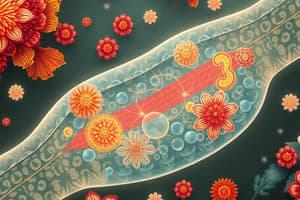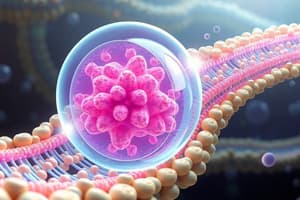Podcast
Questions and Answers
What characteristic of the cell membrane helps maintain homeostasis within the cell?
What characteristic of the cell membrane helps maintain homeostasis within the cell?
- It allows any molecule to pass through.
- It reacts with all types of molecules.
- It is impermeable to all molecules.
- It is selectively permeable. (correct)
What is the primary reason small non-polar molecules can easily pass through the cell membrane?
What is the primary reason small non-polar molecules can easily pass through the cell membrane?
- They can dissolve in the hydrophobic interior. (correct)
- They require energy to cross the membrane.
- They are attracted to polar molecules.
- They are repelled by the water outside the membrane.
What is the term used to describe the movement of molecules from an area of high concentration to an area of low concentration?
What is the term used to describe the movement of molecules from an area of high concentration to an area of low concentration?
- Diffusion (correct)
- Facilitated transport
- Osmosis
- Active transport
Which components are found in the phospholipid bilayer of the cell membrane?
Which components are found in the phospholipid bilayer of the cell membrane?
How does temperature affect the rate of diffusion across a membrane?
How does temperature affect the rate of diffusion across a membrane?
Why are polar molecules unable to pass through the hydrophobic interior of the cell membrane?
Why are polar molecules unable to pass through the hydrophobic interior of the cell membrane?
What is the term used to describe the flexible structure of the plasma membrane, which allows components to float and move laterally?
What is the term used to describe the flexible structure of the plasma membrane, which allows components to float and move laterally?
What determines whether a molecule can pass through the lipid bilayer of the cell membrane?
What determines whether a molecule can pass through the lipid bilayer of the cell membrane?
What occurs in a hypotonic solution?
What occurs in a hypotonic solution?
How does facilitated diffusion differ from simple diffusion?
How does facilitated diffusion differ from simple diffusion?
Which process requires cellular energy (ATP) to occur?
Which process requires cellular energy (ATP) to occur?
Which statement accurately describes a hypertonic solution?
Which statement accurately describes a hypertonic solution?
What describes active transport most accurately?
What describes active transport most accurately?
In which process do vesicles fuse with the cell membrane to release their contents?
In which process do vesicles fuse with the cell membrane to release their contents?
What is the main mechanism for the passage of small, non-polar molecules through the cell membrane?
What is the main mechanism for the passage of small, non-polar molecules through the cell membrane?
What is the result of active transport in neurons?
What is the result of active transport in neurons?
Flashcards
What is the cell membrane?
What is the cell membrane?
The cell membrane is a thin, flexible barrier that surrounds every cell, regulating what enters and leaves the cell.
What is the cell membrane made of?
What is the cell membrane made of?
The cell membrane is composed of a phospholipid bilayer, a double layer of phospholipid molecules with hydrophilic heads (water-loving) and hydrophobic tails (water-fearing).
What are the types of proteins in the cell membrane?
What are the types of proteins in the cell membrane?
Integral proteins span the entire membrane, while peripheral proteins are attached to one side.
Why is the cell membrane called a 'fluid mosaic'?
Why is the cell membrane called a 'fluid mosaic'?
Signup and view all the flashcards
What is diffusion?
What is diffusion?
Signup and view all the flashcards
What is a semi-permeable membrane?
What is a semi-permeable membrane?
Signup and view all the flashcards
What is osmosis?
What is osmosis?
Signup and view all the flashcards
What determines if a molecule can cross the cell membrane?
What determines if a molecule can cross the cell membrane?
Signup and view all the flashcards
Osmosis
Osmosis
Signup and view all the flashcards
Hypotonic Solution
Hypotonic Solution
Signup and view all the flashcards
Hypertonic Solution
Hypertonic Solution
Signup and view all the flashcards
Isotonic Solution
Isotonic Solution
Signup and view all the flashcards
Passive Transport
Passive Transport
Signup and view all the flashcards
Simple Diffusion
Simple Diffusion
Signup and view all the flashcards
Facilitated Diffusion
Facilitated Diffusion
Signup and view all the flashcards
Active Transport
Active Transport
Signup and view all the flashcards
Study Notes
Cell Membrane Structure and Function
- The cell membrane regulates what enters and leaves the cell
- It provides some protection and support
- Also known as a phospholipid bilayer
- Contains phospholipids with hydrophilic (water-loving) heads and hydrophobic (water-fearing) tails
- Also has integral (spanning the entire bilayer) and peripheral proteins
- Cells exist in an aqueous environment (mostly water)
- The plasma membrane is often described as a "fluid mosaic" due to its flexible, dynamic structure with many components
- Molecules move laterally (side-to-side) within the membrane
Diffusion
- Movement of molecules across a membrane from an area of high concentration to an area of low concentration
- Does not require energy input
- Rate affected by temperature, molecule size, and concentration gradient
Selectively Permeable Membrane
- Allows only certain molecules to pass through
- Critical for cell homeostasis and maintaining internal environment
Factors Affecting Membrane Permeability
- Size: Small molecules pass more easily
- Charge: Nonpolar molecules pass more readily; polar molecules (and ions) do not pass easily through the hydrophobic interior.
Osmosis
- Movement of water across a semi-permeable membrane from an area of low solute concentration to an area of high solute concentration
- Hypotonic solution: Solute concentration outside the cell is lower than inside, water moves into the cell (cell may burst - lysis)
- Isotonic solution: Solute concentration outside the cell is equal to inside, no net water movement
- Hypertonic solution: Solute concentration outside the cell is higher than inside, water moves out of the cell (cell may shrivel - plasmolysis)
Passive Transport
- Movement of substances across a membrane without energy expenditure
- Simple diffusion: Small nonpolar molecules (e.g., oxygen, carbon dioxide) pass directly through the membrane
- Facilitated diffusion: Movement of molecules through a transport protein (e.g., channel or carrier proteins). Does not require energy input, but uses proteins to facilitate movement from high to low concentration.
Active Transport
- Movement of substances across a membrane using energy expenditure (ATP)
- Moves substances against their concentration gradient (from low to high concentration)
- Example: Sodium-potassium pump (Na+-K+ pump) in neurons
Bulk Transport
- Exocytosis: Movement of materials out of the cell (e.g., release of neurotransmitters)
- Endocytosis: Movement of materials into the cell. Includes phagocytosis ("cellular eating", e.g., immune cells ingesting bacteria) and pinocytosis ("cellular drinking").
Studying That Suits You
Use AI to generate personalized quizzes and flashcards to suit your learning preferences.





